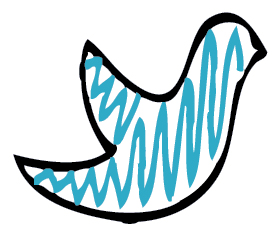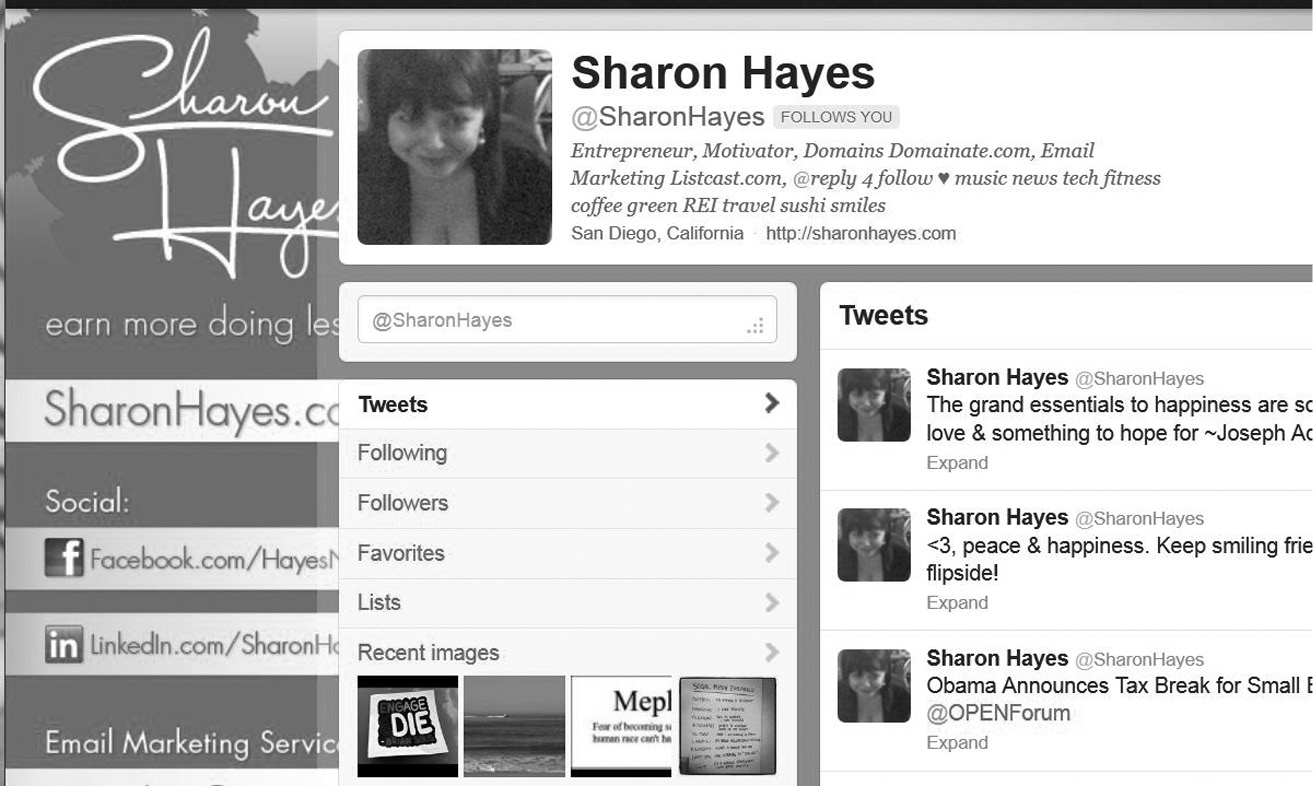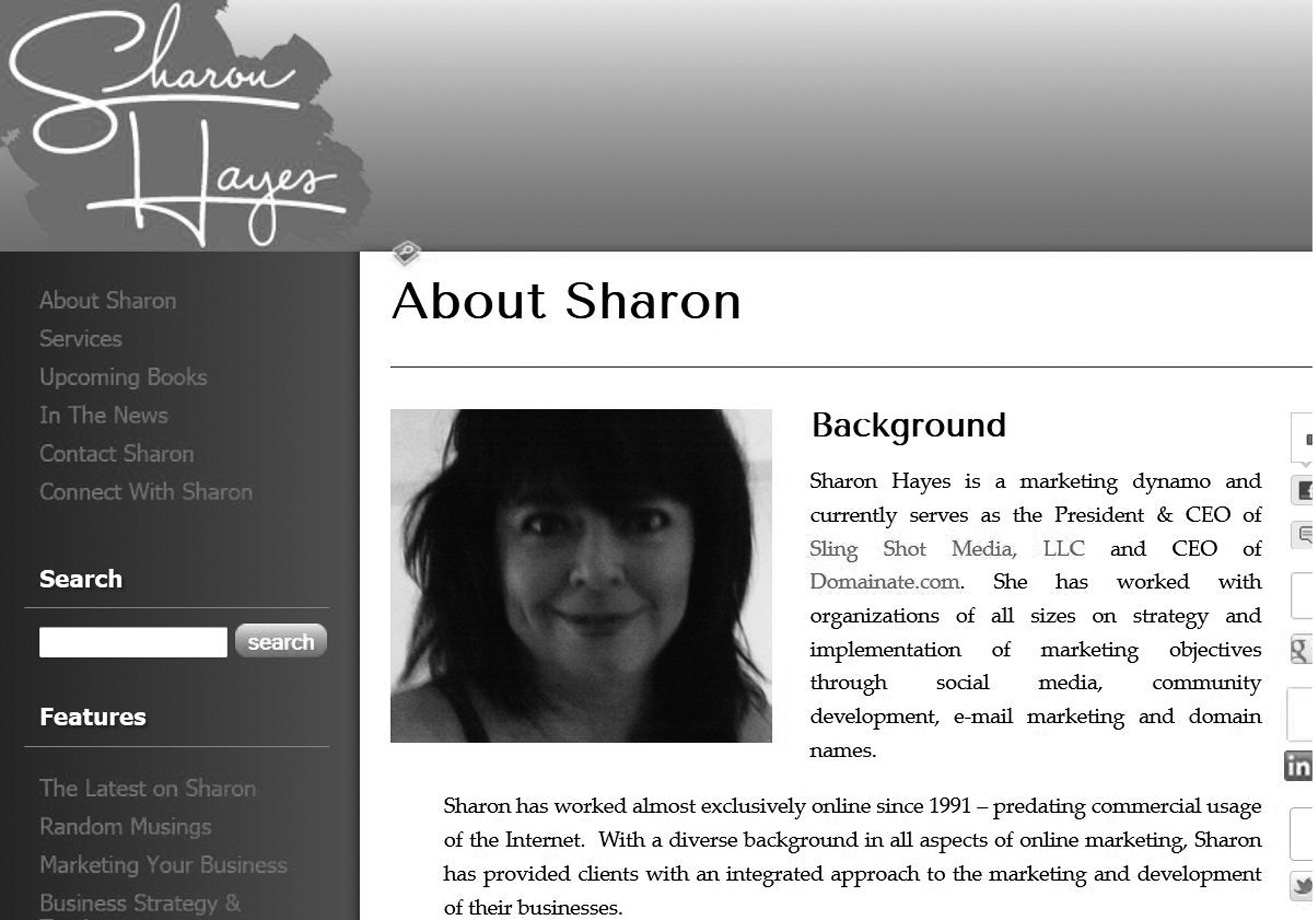Chapter 17
Putting Her Personal Brand in the Pink
“Keep smiling friends and see you on the flip side :)”
@SharonHayes

Sharon Hayes (@SharonHayes) is a leading Twitter lady who knows exactly where she’s going, and it’s straight to the top! A successful entrepreneur whose professional yet lovable personal brand is reflected in her Twitter profile (see Figure 17-1), Sharon is widely respected as a businesswoman. All three of her companies specialize in offering marketing-related business-to-business services online, and all have thrived as a result of her personal brand success. As a leader in online marketing, Sharon has had to be ahead of the curve in social media adoption.
Figure 17-1
Sharon Hayes’s vibrant personal brand shines out from her Twitter profile page.

Skeptical Beginnings
Sharon’s Twitter story began in 2008. She recalls, “Many of my friends and associates were early adopters of social media platforms. In early 2008, I started to receive invitations from people I knew who had joined Twitter. A handful of my clients had also asked about Twitter and my thoughts on how it could be used for business.
“I filed away the invites. I didn’t even look at the Twitter website. I knew, conceptually at least, what Twitter was. You could have people opt in to receive your broadcasts of 140 characters. Since the mid-’90s, one of my core areas has been e-mail marketing, and Twitter seemed to be the text/SMS message equivalent.
“But I couldn’t see how Twitter could work for business. I likened it to the philosophical question ‘If a tree falls in a forest and no one is around to hear it, does it make a sound?’ If people aren’t actually on Twitter and following a business or brand, what is the point? For Twitter to be a viable marketing method, there had to be a critical mass of users. It would take a massive amount of word of mouth work for it to attract users to make it a sensible route for business users to pursue.
“I eventually created an account on Twitter in September 2008. Initially, I just accepted invites I had already received from people. I attended a business conference in Los Angeles the next month and several contacts I made there had Twitter accounts. Until the end of that year, I used Twitter sporadically for conversational purposes and not much else. Somehow, I got to 500 followers and had maybe 200 or 300 tweets.
“In late December, I discovered one thing about Twitter that changed everything — the retweet! At the time, Twitter had no built-in retweeting function. There was only manual retweeting. I shared a link to one news article, which ended up going viral because of others retweeting it. At the time, people seemed hungry to find new, interesting people to follow. I not only found this one tweet being recirculated, but I also picked up a few dozen new followers the same day.
“A good deal of the online marketing work I’ve done has been related to viral campaigns. Finding out what retweets could do exposure-wise — I literally felt like I had found the Holy Grail. My enthusiasm for Twitter rapidly kicked in and has stayed with me since.”
Taking a Client’s Perspective
Sharon’s use of Twitter has been what she terms as “an ongoing experiment of sorts.” She believes her situation is unique, as although she uses Twitter under her own name, her companies are not tightly linked with her name. She explains, “The average dollar value of a client for me is typically quite high because I deal with larger corporations and organizations. I was more interested in how content flowed to help guide clients than I was for personal business gain.
“There’s never really been a point in time where it’s been clear from my tweets what exactly I do. I share a variety of information — business, social media, marketing, domains, and motivational — but on the flip side, I also share music, bits of my life, and such. If you look at my tweets, you’ll get a blended view of who I am — both business and personal. It’s pretty well representative of what my work day and life are like.”
In spite of this — or maybe because of this — Sharon has not only built a large following on Twitter but has also gained a significant amount of business.
A Great Example
“One thing to keep in mind when it comes to personal branding today,” Sharon exclaims, “is that people are not buying what you sell but are buying you. Showing a likable persona in social media has resulted in a significant amount of referrals for me.
“I’ll share an example: One of my core business areas is in domain names. My company, Domainate (see Figure 17-2), helps people find an appropriate domain name for branding or rebranding purposes. Let me tell you, I’ve worked on marketing in some capacity for companies in just about every industry, and finding the right domain names has to be one of the most difficult services or products with which to target an audience. Without a substantial budget to market, it can be exceptionally difficult to reach people at exactly the right moment they are in need of a new domain name.
“Almost daily, I have a Twitter follower recommend me to someone they know who needs a new domain name. Do they believe my company is the best at this? Maybe not! But they like me and feel confident in directing their friends, associates, and customers to me.”
Figure 17-2
Sharon’s company Domainate has thrived as a result of her Twitter presence.

Lessons Learned
If she could travel back in time, Sharon tells me there are two things she would have done differently: “First, I would have picked one of the areas I do business in to focus on. Second, I would have maintained a regular blog [see Figure 17-3]. With the explosive growth of social media, I really believe that both of these items are musts for anyone as far as helping with personal branding goes. The situation I put myself in is that I’m known as being a jack of many trades (which I am), but it has probably meant less business this way.”
Figure 17-3
Sharon regrets not having started her blog sooner.

When working with clients, Sharon stresses the importance of having a blog in place before you start work on developing a Twitter presence. She’s just launched a site at BloggingToday.com to help small businesses set up their own blog — another insightful move on her part.
Sharon has also found that, due to the huge number of followers she now has, that time management has become more of an issue. “During my first year on Twitter, there were many days where I spent several hours a day on the service. I was able to engage far more than I do now, but once I got to around 30,000 followers, it became too difficult to interact with people on a mass-conversational level. I used to love throwing out a question to everyone, see the responses come in, and have lengthy discussions as a result. Then it got to the point where the volume of responses was just too overwhelming.
“Currently, I spend 15 to 45 minutes a day most days on Twitter. This is typically split into a handful of short visits. I’ll share a song and for the duration of the song, I’ll respond to some of the incoming tweets I’ve received, retweet one or more things I see from others, and share a couple of things myself. About two-thirds of my tweets are engaging with others. However, most of the tweets interacting with others publicly are lighter in nature. I’ll quickly route serious or extended discussions off Twitter.
“When I come across interesting content during my day, I’ll save it for sharing on Twitter. I don’t go out of my way to find things to share and I try to limit self-promotional tweets to maybe one in 50 or 100 tweets.”
Sharon Hayes’ Golden Rules for Personal Branding on Twitter
Here are Sharon’s ten personal tips for Twitter success:
1. Follow back
Although it looks nice to have more followers than you are following, if you are serious about building a personal brand, I believe adopting ‘follow all back’ (at least for real people) is a good strategy. As I’ve suggested, a lot of business can be generated by referrals.”
2. Use keywords in your bio
Make sure your bio reads well and uses keywords pertinent to what you do, and ensure everything is spelled correctly. Appropriate keywords can help people find you. The rest is about making sure you project a professional image.”
3. Save the best till last
“If you tweet in spurts like I do, try to make sure that your last few tweets are representative of you and what you share on Twitter. For example, make sure that if you interact with others, at least one @ reply shows in your last few tweets. Your last tweet should not be entirely self-promotional. This tip, along with the last one, will help improve the number of people who will follow you back.”
4. Keep it human
“Many people recommend automating sending of tweets. One of the reasons given is to save time. Another reason is that with different time zones, it will allow you to reach more people. I don’t advocate automatic tweeting. I’ve had clients who did this and had major glitches with links proving to be incorrect and other such disasters. At the same time, your followers may not realize you aren’t actually there and it can be frustrating to see tweets coming from someone you’ve asked a question of, or commented to, and not received a response on. Keep the human component in your tweets!”
5. Don’t ruffle any feathers!
“Be neutral on hot topics outside of your core competency. Unless you are a fantastic debater, it’s not worth ruffling feathers and getting into heated discussions with followers.”
6. Remember quality takes time
“At a certain point, it’s best to let your following base grow organically. If you are consistent with your message and doing things right on Twitter, you’ll continue to get new followers. These will be people who are actually interested in the content you share. The number of followers you have on Twitter doesn’t matter, it’s the quality. It takes time to build relationships with people.”
7. Don’t tweet in a bad mood
“If you’re having a bad day, you may want to rethink whether you should go on Twitter. The world won’t fall apart if you don’t tweet one day, but you could do damage to your reputation and personal brand if you interact with others when you aren’t in good form.”
8. Keep it upbeat!
“Keep your complaints to a minimum. Many people go on Twitter as a means to escape. They don’t want to be subjected to unnecessary negativity. Unless, of course, being a downer is your thing! So, try and keep it upbeat.”
9. Inject your tweets with brand ‘you’
“You want to inject some of your own personality into things. If you share links, try and add your own comments to them. Don’t be a broadcast-only channel; instead, interact and engage with others.
Also keep in mind that most people recognize avatars more than names. When building a personal brand, you should always use a photograph of yourself. I believe it’s important to make sure that if you change photos, it should still be apparent that it is you. I’ve had some disasters when changing my photo where many people didn’t recognize me. As a result my retweet volume and engagement level dropped dramatically.”
10. Reciprocity rules
“Remember that reciprocity rules in social media! On Twitter, this means that if you want others to share your content, share theirs. Don’t ask people to retweet something of yours if you’ve never interacted with them or shared something of theirs. I’d actually suggest not asking in general. Avoid using the Twitter retweet button; instead manually retweet because this gets more visibility.”
Sharon Hayes’ Favorite Twitter ToolsSharon uses three primary Twitter tools: CoTweet, Friendorfollow.com, and Twitter Lists.
CoTweet is a web-based Twitter management platform that allows you to see your mentions, your stream, individual profiles of people, and previous exchanges with users, as well as have saved searches running. The platform also provides built-in reporting of who is retweeting your content and when, what your top content retweeted is, and more. Sharon had used other third-party applications to view statistics, but found the ones provided in CoTweet to be the most robust and the most accurate because they also show protected users.
CoTweet lets you schedule tweets and, although she doesn’t send out tweets when she’s not around, Sharon will schedule some tweets to go out at intervals, so that they don’t flood less active users’ streams. “In five or ten minutes, I can easily reply to ten or 20 tweets, but I will queue them to go out over a half hour or hour.”
Sharon also loves the history feature of CoTweet, where she can view all past communications with a specific user. “It saves me from having to remember details,” she says.
Sharon also uses Friendorfollow.com’s paid version because it allows her to “unfollow those who have unfollowed me. It is the only tool I’ve found to be accurate in showing who is or isn’t following,” she claims.
Additionally, Sharon is an extensive user of Twitter Lists (shown in Figure 17-4). She has broken her lists into multiple ones, including those for people who retweet her, news sources, and closest friends. Twitter Lists has saved her a considerable amount of time finding those things she wants to reshare or respond to.
Figure 17-4
Sharon has found Twitter Lists to be a great way to organize her followers.

Sharon believes that the Twitter tools she uses have enabled her to spend less time on the platform, without being any less effective in her stream. “All told, with the way I manage my Twitter account and the tools I use, it is rare that I spend more than three hours a week on Twitter. This is without any kind of automation!”
Sharon shows that you don’t need to have a permanent Twitter presence to make a powerful impact. What you do need is a strong personal brand message that translates well in the tweets you do choose to send out each day, and that’s something that Sharon has in buckets!

